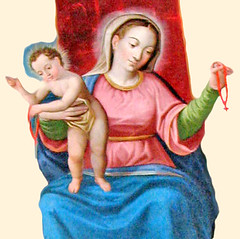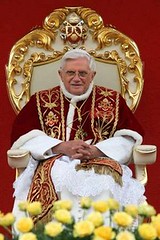Walking St Therese's Little Way with Balthasar
 Station at Saints Sylvester and Martin
Station at Saints Sylvester and MartinThe Station is a sanctuary situated on the Esquiline hill. A holy priest (called Equitius) had given his house to Pope St Sylvester to turn into a church, and this titulus Equitii was built in the 4th century as one of Rome's twenty-five parish churches on the site of Trajan's Baths. It was initially an oratory devoted to all the martyrs because relics were transferred here from the Catacombs of Priscilla. It is known that a local synod or preparatory meeting for the Council of Nicaea took place here. It is believed that the Nicene Creed was first proclaimed here in Rome. In the 6th century, Pope St Symmachus built a new church next to the first basilica on a higher level and dedicated both to St Martin of Tours and Pope St Sylvester. This church has since been rebuilt and restored several times, most notably by St Charles Borromeo and it is now served by Calced Carmelites. Two Roman pontiffs were titular cardinals of this church: Pope Pius XI and Pope Paul VI.
This Station allows us to give a Carmelite character to our reflection today. Of all the saints, Von Balthasar had a great admiration for the Little Flower, St Therese of the Holy Face and of the Child Jesus, or St Therese of Lisieux as she is more popularly known. He wrote at least one book on her life and spirituality and another about her contemporary Carmelite, Blessed Elizabeth of the Trinity. Calling them 'Sisters in the Spirit', these books have now been combined and Balthasar would often refer to St Therese of Lisieux and her 'little way'. Is there not perhaps another common thread between Balthasar and Pope John Paul II in that both had such love and admiration for this simple Carmelite saint? The late Holy Father proclaimed her a Doctor of the Church in 1997, the only one so honoured in his long pontificate.
Continuing our Von Balthasar week then, following is an extract from Balthasar's reflections on the example of St Therese of Lisieux - she whose vocation is Love - and her contemplative way. She has much to teach us, especially in Lent when we renew our struggle to let love permeate our every action, to follow her little way, her way of loving, a via crucis of sorts. Cardinal Von Balthasar writes:

"In recent times we do not have so many great saints that we could afford to make it without them. One might perhaps object that the designation 'great saint' does not exactly fit the 'little' Teresa with her doctrine of the 'little way' which was described by her explicitly and carefully as a way for all Christians, and precisely for 'little souls'... it is enough to note that the fervour of veneration for her across the entire world has surely been fanned by the breath of the Holy Spirit and that one applies the expression 'great saint' at best to those who have been borne toward canonization by the Holy Spirit itself (and especially not by human interests), as for example the Cure of Ars or Don Bosco...
Now great saints are not dependent upon advertising, but at most upon the love of the faithful, and this love arises whenever there is a feel for the special quality of their mission and for the suitability of its execution. [Anyone who reads Therese's writings] will be astonished at the freshness and genuineness one immediately encounters, the indomitable temperament, the will to convince, to bring one along, the impatience with all tepidity, all resignation, all false humility... We must note that in recent times no canonized saint is known to me who possessed such a poetic capacity as Therese of Lisieux. The images really bubble forth from pen, always original, always striking home. They illustrate her teaching about the little way, that it thereby becomes more colourful, intelligible, and attractive...
The 'little way' is so called, because it always undertakes to prescribe only the next step that needs to be taken right now. No high-flying plans for tomorrow, but the little bit that is required today, in this hour and minute.
Maybe we put up with an unpleasant person. Maybe we persevere in patience with some work, without stopping early. Maybe we go to the end of some prayer in which apparently nothing will come out right. Only today counts, even though the spirit would so much like to dream about tomorrow. To be sure, this today is transitory; Therese feels this urgently and longs for eternity with God. But for now God is nowhere else comprehensible than just in the now. Eternity, that to us seems to lie in the future, is in truth the hidden depth of the present moment. When I fill up this moment with Christian love, as much as I can, to the limit, then I am in contact with the eternal, with divine love, which accompanies me from moment to moment...
In the 'little way' there is no separation or opposition between love of God and love of neighbour. Such a distinction would never have occurred to Therese; from her earliest youth, she sees both as the full Christian unity of life.
For her, it is completely obvious that she loves God because he is love, love for all human beings, for all sinners, because he - as she says so many times - went to the point of madness in this love for humanity. For her, God and eternal life, in the abyss of the love of God, is the whole meaning of creation; this is why she wants to lead as many people as possible to this God, precisely because she loves human beings...As a Carmelite, Therese understands that she cannot make her love known by outward works in the Church: her 'work' is the total self-giving of love, the 'whole burnt offering', which she knows is the most efficacious, most fruitful action of the Church. She compares herself to a small pendulum that sets all the great wheels of the ecclesial apostolate in motion. And the Church has for its part acknowledged this insight of Therese by declaring her the patroness of the missions. She understands her works to be the product of a complete selflessness: she wants to do no good deeds and to collect no profits; but rather to radiate everything before her for the benefit of the world and the good of the Church. And so much does she understand this action to be the definitive attitude of Christian love, that even in heaven she wants nothing but to be for God the 'defoliated rose', whose petals are wafted down over the earth...
One has to break through superficial outer skins, and then one sees with astonishment: Therese has answers, yes, in large part the answers to questions and problems of the Church in our time. The breakthrough that she signified for us in no way lies finished behind us. First she has the right answer to the slogan of orthopraxis: her little way is nothing else. But it really lives, as it would have to, as Christian, completely out of loving faith. She has the right answer to the problem posed between love of God and love of neighbour, for she shows us that both in truth are one and each side always inevitably refers to the other..."
Does not this final sentence have strong echoes in Deus Caritas Est? As we consider how we can respond to the Pope's encyclical, there is perhaps no better saint to call upon than St Therese of Lisieux. May she shower her roses upon us, guiding us along her little way, Christ's own way of love, and may Ss Sylvester and Martin pray for us.
The icon above left depicts St Therese of the Holy Face and the Child Jesus, written by Fr William McNichols SJ and on right, St Therese's relics are being carried into Valletta Co-Cathedral in Malta by Carmelite friars.







0 Comments:
Post a Comment
<< Home